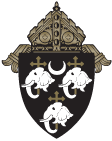Written by Mary Beth Peabody
Joan DiCicco is a self-proclaimed curriculum geek. A second grade teacher, DiCicco is serving on her third curriculum redesign team for South Jersey Catholic Schools — first math, (ELA) and now social studies. As a team lead for the ELA redesign, DiCicco and three colleagues spent two weeks with educators from the Alliance for Catholic Education (ACE) at the University of Notre Dame.
“[ACE] helped us understand how to get teachers to collaborate,” she said. For the next three years, DiCicco and nearly 60 other diocesan teachers developed an integrated ELA curriculum, which was rolled out in grades K through 12 for 2017-18 school year.
“The curriculum offers the freedom to move away from the [text] book, be more holistic, introduce other components,” said DiCicco, who teaches at Saint Rose of Lima in Haddon Heights. She also said the curriculum encourages cross-subject learning — for example rounding out an ELA teaching unit with science-based readings.
“The ELA curriculum is so student-centered,” said Melissa Brino, a fifth grade teacher at Saint Mary’s in Williamstown. “It’s [about] getting kids to think about what they’re learning. Taking kids in new directions.” Brino was involved with the Science and ELA design and is now on the social studies curriculum team as well.

Dr. Bill Watson, director of curriculum and assessment for South Jersey Catholic Schools, has been a steady guide for all curriculum design since he joined the diocese in 2013. At that time, the science curriculum was under reconstruction.
“The curriculum begins with the end in mind,” he said. “We start by looking at what we want students to be able to do in a subject area by the end of high school and work backward. We have a big picture that can be broken down into units of study in each subject, for every grade, with the related skills our students should be acquiring. We’re not just checking off a list of covered topics. Instead, we’re integrating concepts and subjects to help students develop their own thinking skills.”
Watson said teachers follow the study units but are free to choose textbooks and supplemental materials to achieve their goals.
Gloucester Catholic high school English teacher Sharon Zucarelli said the rollout was well received by her colleagues, especially since the new curriculum did not require starting all over with lesson plans. She said the recommendation to teachers was “Take a look at what you have. Take a look at the curriculum. See where the pieces fit.’”
Zucarelli said she was grateful for the opportunity to collaborate with teachers from other schools and across grade levels. “We’re not operating in isolation,” she said, describing the process as collegial and academic, resulting in a “nice picture of exactly what students should know.”
Math teacher Stephanie Callahan, from St. Mary’s in East Vineland, helped develop and roll out the math curriculum across the diocese. Like Zucarelli, she found the response to be overwhelmingly positive. “Teachers took ownership the first day [of training]. They wouldn’t even take a break,” she said.
Maria Howard, who teaches religion, social studies and math in fifth through eighth grades at Saint Joseph’s elementary school in Hammonton, said the collaborative process is different from public schools, where the curriculum is handed down. “We write it,” she said. “The units are goal-oriented, flexible, real-world problem solving. … We’re more aware of the big picture.”
Watson acknowledges a key advantage is that the curriculum is not based on teaching to a test. “We’re guided by ACE, New Jersey core curriculum and other standards, but we can go so much further. And of course that includes bringing our Catholic faith and values into every area of study,“ he said.
Holy Angels science teacher Matt Tornese said the diocese’s science curriculum was adopted based on Next Generation Science Standards, but is more cutting edge. “The focus shifted from content to skills — being able to do the science and understanding how it works. … I’ve always tried to focus on the why, but the curriculum supports and helps ensure that way of thinking,” he said.
Mary Beth Peabody is Communications and Marketing Manager, Office of Catholic Schools, Diocese of Camden.
